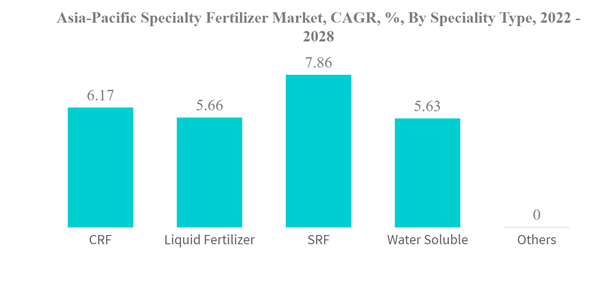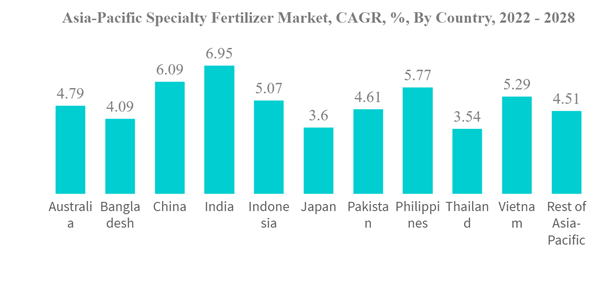Key Highlights
- Largest segment by Speciality Type - Water Soluble : The water soluble fertilizers are the efficient fertilizers which can reduce the fertilizer application by 25-30%, with even distribution of fertilizer throughout the field.
- Fastest growing by Speciality Type - SRF : The SRF are safe to the soil and environment as they precisely release the nutrients in to the soil throughout the cropping season and thus reduce the leaching of nutrients.
- Largest Segment by Crop Type - Horticultural Crops : There is an increasing trend in the fertilizer use due to the shift of growers from field crop to horticultural crop, which led to a 1.46% increase in area between 2020-2021.
- Largest segment by Country - China : China is the most populous country in the world and has large cultivable land in the region, with high fertilizer aplication rate per hectare to maximize the crop yields.
APAC Specialty Fertilizer Market Trends
Water Soluble is the largest segment by Speciality Type.
- The specialty fertilizers market in the region grew by 18.94% during the study period. The market is estimated to record a CAGR of 5.26% during the forecast period.
- China, India, and Japan dominated the market by 40.2%, 23.8%, and 6.5% in 2021. China is the top manufacturer and consumer of specialty fertilizers in the region. Countries like China and India are being targeted by fertilizer manufacturing firms due to their large population, land availability, diversified climatic regions, and liberal government policies of fertilizer trials, further driving the market's growth.
- Field crops dominated the market with a share of 80.7% in 2021. Field crops were the major consumers of polymer-coated, urea-based controlled-release fertilizers in 2021, accounting for 70.3%. The application of poly-coated urea helps decrease the disparity between soil N availability and plant N demand. As a result, there is an increase in the adoption rate of cutting-edge fertilizers, like poly-coated fertilizers.
- Fertigation is the most commonly used fertilizer application method, accounting for 51.11% of all fertilizer applications due to the disadvantages of foliar fertilizer, which can harm the plant if not applied correctly. Increased nutrient concentrations in the foliar spray may end up causing leaf burn as water evaporates and salts remain. Thus, foliar application accounts for a 43.7% share of the market.
- The awareness of and demand for specialized fertilizers, such as liquid and water-soluble fertilizers and controlled-release fertilizers, in the production of crops have grown quickly in recent years as farmers seek to maximize the yield per planted hectare. This factor is anticipated to drive the market in the future.
China is the largest segment by Country.
- The Asia-Pacific specialty fertilizers market was dominated by field crops, accounting for 84.98% of consumption volume, followed by horticultural crops by 14.37%. Turf and ornamentals accounted for a share of less than 1% in 2021. China leads the field crops segment in terms of total specialty fertilizer market value with a share of 43.04%, followed by India with a 17.15% share, Japan with a 16.35% share, Indonesia with 5.67%, and Australia with 4.07% of the Asia-Pacific specialty fertilizer market value in 2021.
- The Chinese specialty fertilizer market accounted for the largest share of the fertilizer market in terms of value, which was 44.19% of the total specialty fertilizer market in the Asia-Pacific region. Major crops produced in the country include rice, wheat, and maize.
- In the Asia-Pacific region, India is the second-largest fertilizer consumer after China. Specialty fertilizers are innovative nutrient sources used in specific soil and plant conditions to trigger special responses that improve plant growth and productivity. The market grew significantly from USD 5.6 billion in 2017 to USD 6.6 billion in 2019, with a dip in 2020 due to supply chain disruptions caused by COVID-19.
- In Japan, the value of the specialty fertilizer market makes up about 51.05% of the total fertilizer market value in the country. Fertilizers used for fertigation account for 63.18% of the market for specialty fertilizers as fertigation makes it easier for the active root zone to get nutrients and water. levels of absorption in plants are improved by this method.
- Due to repeated cropping without sufficient time for the soil to regain its fertility, Asia-Pacific soils are becoming unsuitable for cultivation. The market is expected to be driven by specialty fertilizers that provide timely nutrition while having a low environmental impact.
APAC Specialty Fertilizer Industry Overview
The Asia-Pacific Specialty Fertilizer Market is fragmented, with the top five companies occupying 19.44%. The major players in this market are Compo expert, Coromandel International Ltd., Israel Chemicals Ltd, Sociedad Quimica y Minera de Chile SA and Yara International ASA, (sorted alphabetically).Additional Benefits:
- The market estimate (ME) sheet in Excel format
- 3 months of analyst support
Table of Contents
Companies Mentioned (Partial List)
A selection of companies mentioned in this report includes, but is not limited to:
- Compo expert
- Coromandel International Ltd.
- Haifa Group
- Hebei Sanyuanjiuqi Fertilizer Co., Ltd.
- Huaqiang Chemical Group Stock Co., Ltd.
- Israel Chemicals Ltd
- Sociedad Quimica y Minera de Chile SA
- Yara International ASA,
- Zhongchuang xingyuan chemical technology co.ltd
- Zouping Hongyun Biotechnology Co., Ltd.










